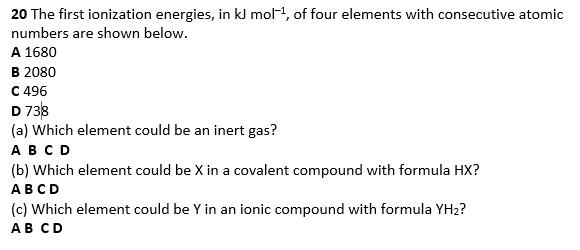MCQ Help

Can someone explain Part B and C please, I mean I guessed correctly but I dont really understand why in this case, just because I know halogens make HX but does group 2 make MH2?
The key thing about this question is that it states the elements have consecutive atomic numbers.
Assuming the period doesn't change, which it could, but based upon the questions asked seems unlikely:
As one of them is an inert gas (that being B due to it having the greatest first ionisation energy) then the others must be a part of group 7 (that being A - next highest ionisation energy), group 6 (D for the same reason as previous) and group 5 (for the same reason as the other two).
Thus, X is evidently the halogen, so is A.
Y is a compound that bonds to two hydrogen atoms - group 6 elements are elements which regularly do this e.g H2O. Thus, Y must be D.
Assuming the period doesn't change, which it could, but based upon the questions asked seems unlikely:
As one of them is an inert gas (that being B due to it having the greatest first ionisation energy) then the others must be a part of group 7 (that being A - next highest ionisation energy), group 6 (D for the same reason as previous) and group 5 (for the same reason as the other two).
Thus, X is evidently the halogen, so is A.
Y is a compound that bonds to two hydrogen atoms - group 6 elements are elements which regularly do this e.g H2O. Thus, Y must be D.
Original post by Kozmo
The key thing about this question is that it states the elements have consecutive atomic numbers.
Assuming the period doesn't change, which it could, but based upon the questions asked seems unlikely:
As one of them is an inert gas (that being B due to it having the greatest first ionisation energy) then the others must be a part of group 7 (that being A - next highest ionisation energy), group 6 (D for the same reason as previous) and group 5 (for the same reason as the other two).
Thus, X is evidently the halogen, so is A.
Y is a compound that bonds to two hydrogen atoms - group 6 elements are elements which regularly do this e.g H2O. Thus, Y must be D.
Assuming the period doesn't change, which it could, but based upon the questions asked seems unlikely:
As one of them is an inert gas (that being B due to it having the greatest first ionisation energy) then the others must be a part of group 7 (that being A - next highest ionisation energy), group 6 (D for the same reason as previous) and group 5 (for the same reason as the other two).
Thus, X is evidently the halogen, so is A.
Y is a compound that bonds to two hydrogen atoms - group 6 elements are elements which regularly do this e.g H2O. Thus, Y must be D.
h2o is not ionic though so surely it cannot be group 6
Original post by TheTennisOne
h2o is not ionic though so surely it cannot be group 6
Ahh, yes, good point - my bad, didn't entirely read the question.
So, presumably Y is a group 2 compound and so the consecutive elements continue over a period. But, that still works nonetheless - Y must be D for the following reason(s):
Let's assume that we're initially talking about period 3:
A = the halogen, group 7 period 3 = atomic number 17 (chlorine). = compound X
B = the noble gas = atomic number 18 = higher ionisation energy than the halogen as it is further right.
C = a group 1 compound. = ionisation energy drops as we are moving up to the next full energy level.
D = a group 2 compound (in our theoretical example atomic number 20) = ionisation increases as the proton number increases while shielding / distance from nucleus stays constant, but still lower than A and B because it's in a higher energy level (4s in our case, instead of 3p). = compound Y
It therefore appears that the order they gave the answers in (A, B, C, D) was the literal order in which the atomic number increased. If that had of been more clear, the question would have been much easier in my eyes.
Quick Reply
Related discussions
- CIE AS Level MCQ
- LPC - Best way to prepare for multiple choice questions?
- Assessment closed before deadline
- Physics A-level
- How to prepare and ace theory test??!!!
- Full marks LNAT
- Online mcqs postgraduate study
- MME AQA predicted physics a level papers
- UCL LNAT score 2024
- Lets walk through Year 11 together!
- How to study for MAT/TMUA?
- AS chemistry paper 2 2022 AQ
- calculating marks help
- Maths help
- Free LNAT prep materials
- Online SQE PREP babri vs QLTS?
- KCL Nursing 2024
- LNAT MCQS- 4 options or 5 options
- PWC flying start online assessment
- SQE 1 Question Banks
Latest
Trending
Last reply 1 week ago
Im confused about this chemistry question, why does it form these productsTrending
Last reply 1 week ago
Im confused about this chemistry question, why does it form these products



